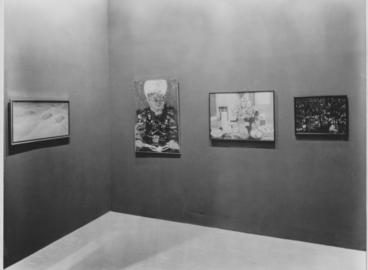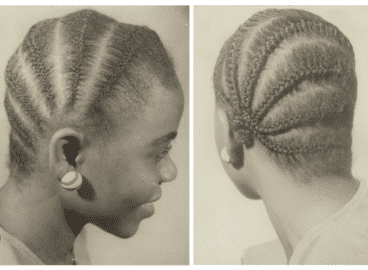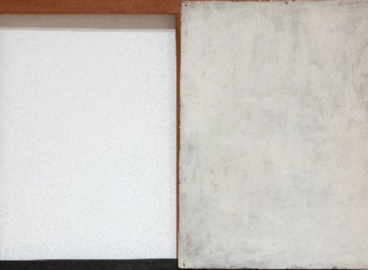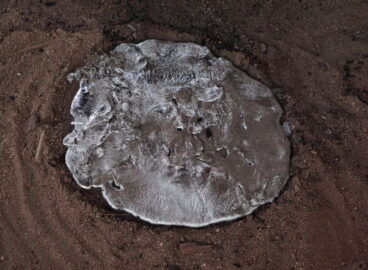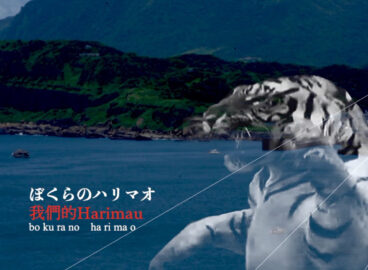Collaborating artists Amy Lien and Enzo Camacho take a speculative approach to Alfonso Ossorio’s Empty Chair or The Last Colonial (1969), currently on view in Gallery 415. Drawing on their extensive research on Ossorio, a Filipino-American modernist who produced a rich and highly eccentric body of work, Lien and Camacho attempt to locate a kind of insurgent potential bubbling underneath the picture’s baroque aesthetic.
This picture is a thirst trap, a clusterfuck of Day-Glo-dipped lucky charms that you just can’t look away from. Everything seems to swirl around a bull’s-eye target rendered in neon red. You are told that this is a “chair” and that this chair is “empty,” which is an implicit invitation to take a seat. Two feet (actually, wooden shoe trees) positioned on either side of the circular form provide a rough guide for how to orient yourself in relation to the picture. You must straddle and squat, assume the position. In the middle of the target—right at the bull’s-eye—there is a disk-shaped piece of coral, perfectly round, puckered, and rimmed with jewels, resembling a royal-class anus. The anus punctures the chair. It carves out an orifice, a squinting, portal-like hole seemingly held open by four rusty nails that have been hammered into the bejeweled perimeter. What is this anus to yours? Will they kiss in your mind-space?
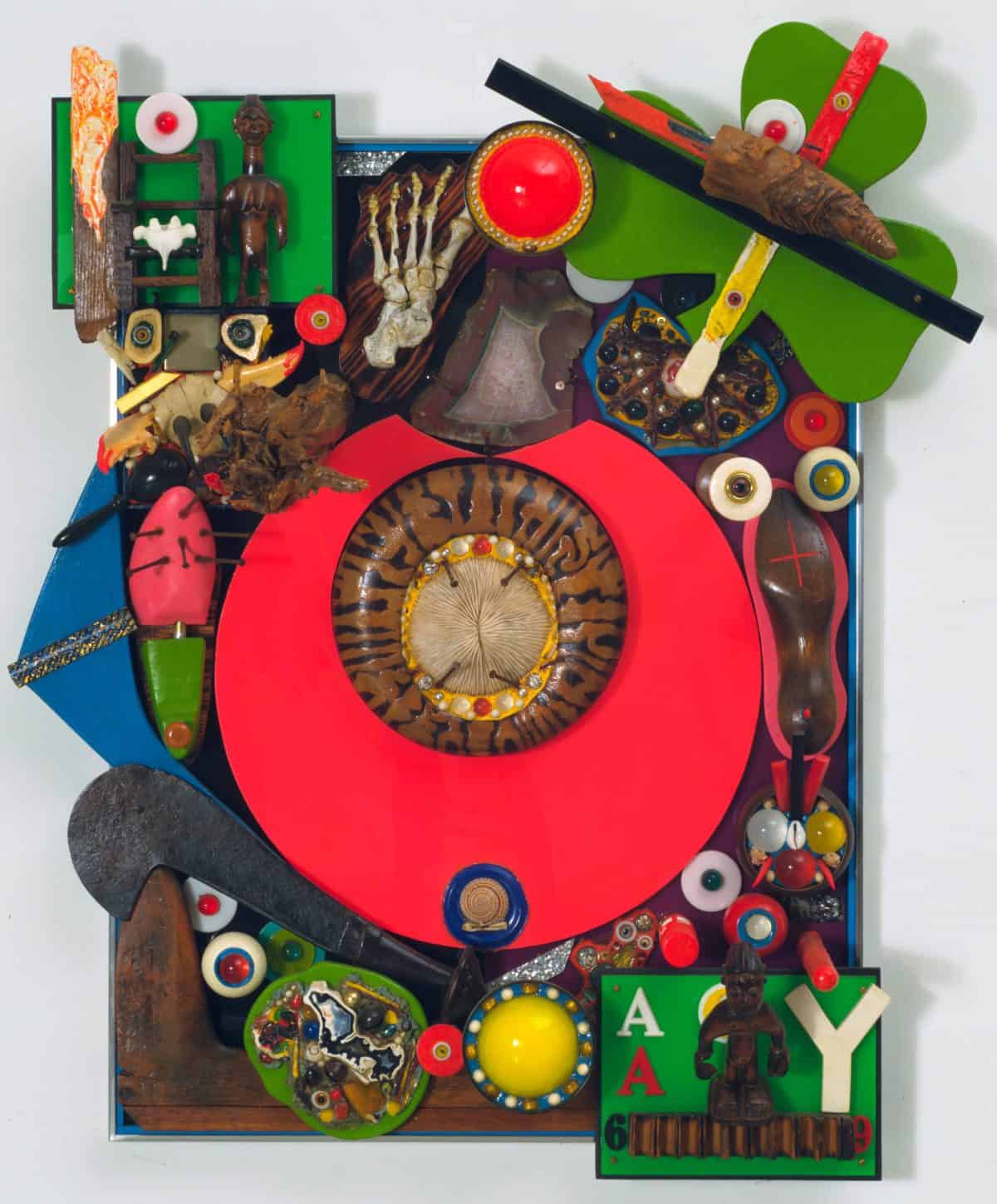
Empty Chair or The Last Colonial (1969) reframes the act of looking as an act of intimate communion—both spiritual and bodily. Alfonso Ossorio (1916–1990), the artist who created this picture, compared this mode of looking to that of peering through a telescope or microscope: “It is flat but it is also transparent and enables you to see more than you would with your naked eye. That is the way the picture plane should be looked at in most of my work. The surface is very much there, it is emphasized with protuberances, but it is also meant to be permeable. It is dense and permeable.”1Alfonso Ossorio, interview by Judith Wolfe, in Alfonso Ossorio, 1940–1980: Guild Hall Museum, East Hampton, N.Y., July 19th–August 17th, 1980, exh. cat. (East Hampton, NY: Guild Hall Museum, 1980), 22–23. Emphasis original.
This paradoxical approach to modernist picture-making was shaped by a similarly paradoxical set of life experiences. Alfonso Ossorio was born in the Philippines in 1916 to a wealthy mestizo family that would soon become central players in the local sugar industry. But he would leave the country as a young child to study abroad, eventually gaining US citizenship. During the ’40s and ’50s, he moved between North America and Europe, establishing himself in the vibrant avant-garde art scenes of New York and Paris—as an artist, collector, and cultural mediator—and maintaining especially close relationships with artists Jackson Pollock (1912–1956) and Jean Dubuffet (1901–1985). It is easy to see the formative influence that the aesthetic philosophies of Abstract Expressionism and l’art brut had on his work. But despite his deep involvement, we imagine that Ossorio must have been a particularly queer figure in relation to these muscular Euro-American formations, difficult to fully assimilate both socially and artistically. Besides being extremely wealthy, a diasporic Filipino, and persistent in his devotion to explicitly Catholic themes, he was also, in fact, homosexual or bisexual. After going through a failed marriage, he met male ballet dancer Ted Dragon (1921–2011) in the summer of 1947, and they remained together until the end of Ossorio’s life.2B. H. Friedman, Alfonso Ossorio (New York: Harry N. Abrams, 1973).
The psychic tensions resulting from this particular confluence of ethnicity, class, spirituality, and sexuality can be sensed as aesthetic tensions in Ossorio’s work: Density and permeability. Protuberances and orifices. Often there is a complicated interplay between looking as an act of penetration and looking as an act of being penetrated, giving and receiving. Not surprisingly, Ossorio professed an interest in both Freudian and Jungian psychoanalysis.3Ossorio, interview by Wolfe, 46.
As you approach the Empty Chair more closely, various phallic objects seem to aggressively thrust toward you, jutting perpendicularly from the picture plane—a thick and veiny piece of driftwood in the upper left, a slim red stick with a smoothly rounded head in the lower right, and more. The picture delivers a variegated set of libidinal triggers, each object yielding its own erotic texture: The driftwood and the stick offer totally different thrills, as do the jewels, the nails, the shoe trees, the seashells, the bones, the glass eyes, the machete, and the lobster claws that are dripping with red paint. How will you receive these things, and how will they receive you? A skeletal foot appears to be nailed in place above the royal anus, recalling Christ’s divine suffering. Pain and pleasure bleed into one another in an orgy of polymorphous perversity.
Ossorio called these kinds of works “congregations,” implying a sense of spiritual purpose that couldn’t quite be captured in the more familiar “assemblage.”4Alfonso Ossorio, “Oral history interview with Alfonso Ossorio, 1968 November 19,” interview by Forrest Selvig, Archives of American Art, Smithsonian Institution, https://www.aaa.si.edu/download_pdf_transcript/ajax?record_id=edanmdm-AAADCD_oh_212466. He began making them at the very end of the ’50s, after a period of producing thickly impastoed gestural abstractions, and he described how they developed organically from this prior series of works: “Then slowly objects started to get imbedded into the impasto until I had to make a choice whether I would give up doing this or use a medium that was more suitable.”5Ibid. Objects for his congregations were sourced from urban junk shops and remainder stores selling army, navy, or industrial surplus. They were foraged from the beach, from the taxidermist’s workshop, from his circle of friends. “Kind ophthalmologists would send me crates of glass eyes.”6Ossorio, interview by Wolfe, 25–26. Distinctions and hierarchies between the natural and the synthetic, the functional and the decorative, the banal and the precious, were dissolved. Everything could be integrated because everything mattered. This was, in many ways, a culmination of his artistic commitment to tracing a continuum between materiality and divinity, which had driven his practice since the beginning: “It is simply that it is all one unity. Even a little waste piece of plastic or a bone is just as much alive as the abstract concept of God, which is meaningless unless it is incarnated.”7Ossorio, “Oral history interview with Alfonso Ossorio.”
Ossorio commented that his lifelong investment in religious matters stemmed from “a continuing interest in problems, which religion covers, such as birth, death, sex—these particular aspects of humanity.”8Ibid. Clearly, he liked to speak in terms of big, universal themes, a sign of the extent to which he had absorbed the values of Western humanism through his upbringing and education. And yet confronting the specific tensions in Empty Chair seems to elicit a more historically bound reading, one that rubs against the artist’s universalist proclamations.
You are told that this could be an “Empty Chair”—or that it might be “The Last Colonial.” The alternative title dangles like a piece of bait. There is a teasing suggestion here that the pains and pleasures embedded in this congregation of objects are not just “aspects of humanity” but rather aspects of a perverse historical encounter. The work was, after all, produced in the late ’60s, a volatile moment of sociopolitical reckoning charged with the energy of recent revolutions and anti-colonial liberation struggles, when the civil rights and antiwar movements were radically reshaping the public sphere in the US. In a 1968 interview, around the time that he would have been producing Empty Chair, Ossorio noted that he was “a conservative person in many ways” and that “one has to allow things to change if you want to keep essentials the same.”9Ibid. And yet his response to a question regarding the relationship between artistic practice and the intense social upheavals of that era seems to hint at an unconscious insurrectionary drive: “On all of this the artist has to focus in the way a lens focuses a ray of sunlight to make the thing underneath burn.”10Ibid.
Look again at the anus. It seems to be clenched with tension, as though struggling to hold the entire picture together, as though it might burst wide open at any moment from the sheer excess. What divine state waits on the other side of this impending explosion? Will it feel like freedom? If it is possible to transcend the brutal histories that bind us—histories of invasion, rape, enslavement, genocide—surely this will only come through a violent process of sacrifice. And since these histories have soaked through to the very core of our being, this process must ultimately be one of self-sacrifice. In this war of independence, you too must assume the position. The picture sucks you into a sadomasochistic kind of role-play, but one in which there are no preestablished boundaries, no safe words, only encrustations, penetrations, oozing. “In its bare reality, decolonization reeks of red-hot cannonballs and bloody knives.”11Frantz Fanon, The Wretched of the Earth, trans. Richard Philcox (1963; New York: Grove Press, 2004), 3. Your attention lingers on the two wooden figurines stationed at opposing corners of the picture, tourist-kitsch memorials to the indigenous cultures that have been dismembered and degraded over centuries. They seem to be suspended in a state of dreaming. Outside of the picture, history continues to unfurl, never quite arriving at the moment of transcendence but still holding open its possibility.
- 1Alfonso Ossorio, interview by Judith Wolfe, in Alfonso Ossorio, 1940–1980: Guild Hall Museum, East Hampton, N.Y., July 19th–August 17th, 1980, exh. cat. (East Hampton, NY: Guild Hall Museum, 1980), 22–23. Emphasis original.
- 2B. H. Friedman, Alfonso Ossorio (New York: Harry N. Abrams, 1973).
- 3Ossorio, interview by Wolfe, 46.
- 4Alfonso Ossorio, “Oral history interview with Alfonso Ossorio, 1968 November 19,” interview by Forrest Selvig, Archives of American Art, Smithsonian Institution, https://www.aaa.si.edu/download_pdf_transcript/ajax?record_id=edanmdm-AAADCD_oh_212466.
- 5Ibid.
- 6Ossorio, interview by Wolfe, 25–26.
- 7Ossorio, “Oral history interview with Alfonso Ossorio.”
- 8Ibid.
- 9Ibid.
- 10Ibid.
- 11Frantz Fanon, The Wretched of the Earth, trans. Richard Philcox (1963; New York: Grove Press, 2004), 3.
